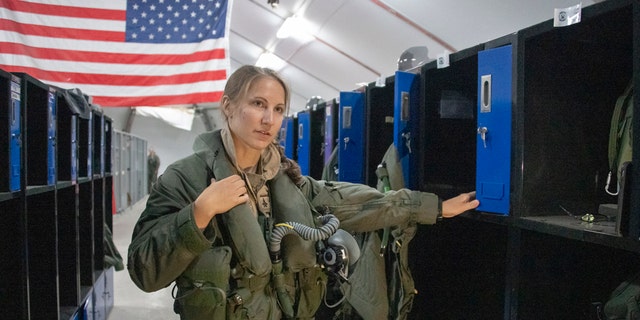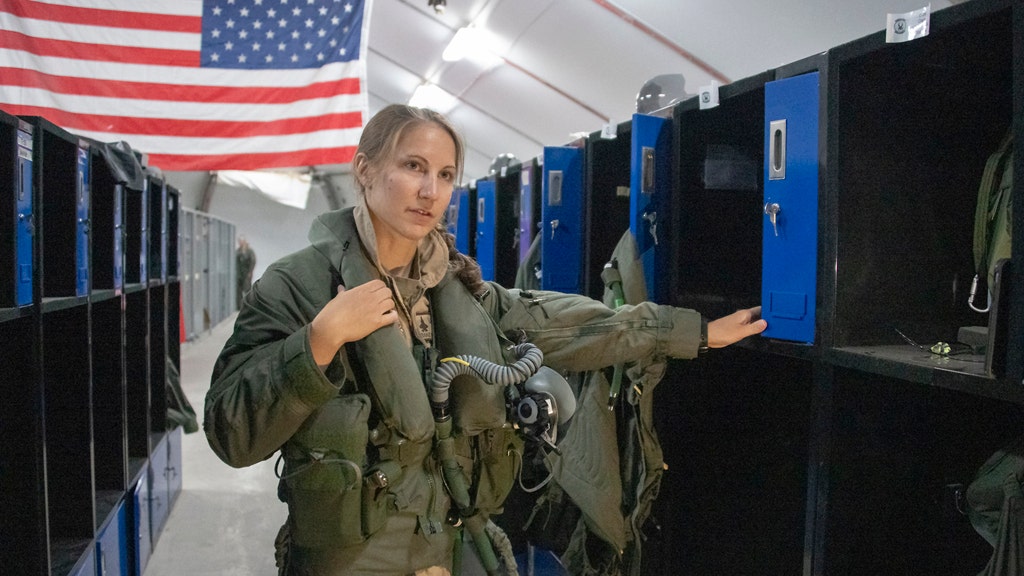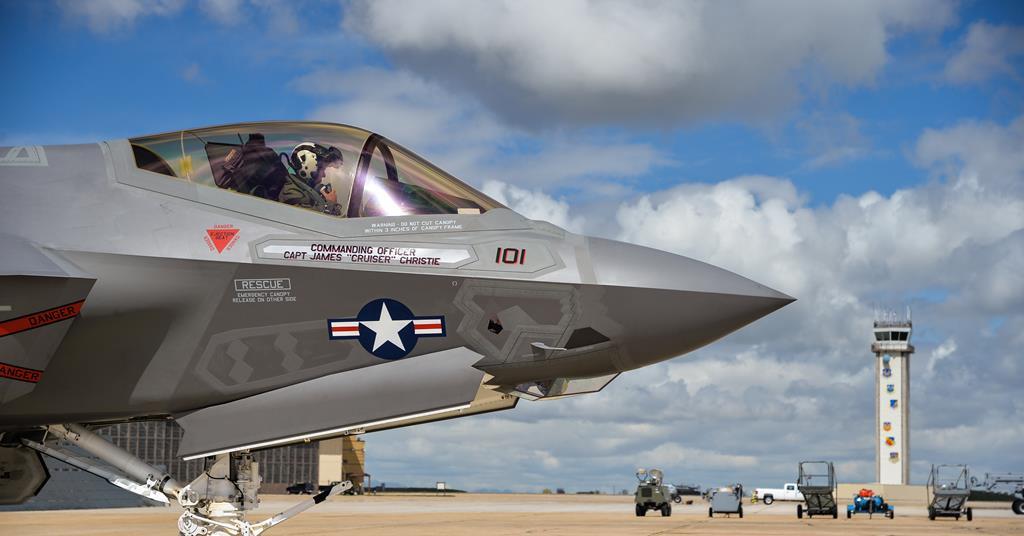The F-35 Joint Program Office is assembling a proposal for dramatic thrust and fuel-efficiency improvements to the Lockheed Martin fighter’s propulsion system.
The options under review include upgrading the existing Pratt & Whitney F135 turbofan and revisiting earlier studies potentially to reengine the fighter in the longer term with advanced adaptive technology to achieve a step change in range and power.Later this year or in 2021, the Joint Program Office (JPO) will submit the F-35 Propulsion Road Map for 2035, which will propose a recommended timeline for consideration by the three U.S. customers as well as international partners, a JPO spokeswoman confirms to Aviation Week.
The JPO will seek funding for the F-35 propulsion upgrade plan in the fiscal 2023 budget, which the Defense Department will unveil in early 2022.
A propulsion upgrade would mark a new phase for the program. The single-engine F-35’s impressive power capacity—up to 28,000 lb. of thrust in full military power and 43,000 lb. of thrust with the afterburner activated for the F-35A and F-35C variants, along with 27,000 lb. of thrust in full military power and 41,000 lb. of thrust with the afterburner activated for the F-35B—has been a constant throughout the program’s nearly 20-year history.
Although the F135 engine is meeting requirements now, the F-35 itself is evolving. The Block 4 Follow-on Modernization program will introduce a major electronics upgrade in Lot 15 aircraft, which are scheduled for delivery in fiscal 2023. As Block 4 introduces new sensors and weapons on the aircraft, the overall weight of the aircraft is increasing, which creates special problems for the short-takeoff-and-vertical-landing F-35B. Moreover, some U.S. and foreign buyers are demanding greater range by improving fuel efficiency, adding external fuel tanks or both.
Anticipating these growing demands on the propulsion system, Pratt has since 2017 proposed a series of upgrades—known as Growth Options (GO) 1 and 2—to support Block 4 requirements, with GO-1 offering either a 6% fuel burn reduction or 10% thrust improvement. Pratt has previously said the GO-2 package reduced fuel consumption by as much as 20%, with a 15% overall thrust improvement. In 2018, Pratt also proposed another two-step upgrade package tailored for the F-35B variant, increasing the vertical thrust generated by the Rolls-Royce LiftFan by 2.5-5%.
The GO-1 package is focused on upgraded materials, blade-geometry refinements and coating improvements in the high-pressure compressor, turbine and combustor. Elements of the upgrade derive from technology tested since 2013 in the U.S. Navy Fuel Burn Reduction program and from the even earlier Air Force-supported component and engine structural-assessment research (Caesar) initiative for the F119 engine that preceded the F135.
The more ambitious GO-2 package leverages variable-cycle advances developed as part of the more recent Air Force Research Laboratory (AFRL) Adaptive Engine Technology Demonstration (AETD) program. Although Pratt has not detailed which specific elements of AETD these involve, they are likely to include the adaptive fan module tested on an F135 in 2017 at the Air Force’s Arnold Engineering Development Complex in Tennessee as well at the company’s facilities in Florida.
AETD was also the forerunner of the Adaptive Engine Transition Program (AETP), which the AFRL launched in 2016 when it awarded contracts worth $1 billion each to General Electric and Pratt to design, build and test prototype 45,0000-lb.-thrust-class adaptive engines. The new centerline designs exploit technology developed under the earlier Adaptive Versatile Engine Technology and AETD, both of which tested ways of dynamically modulating a third stream of air between the engine’s core and bypass duct. The variable-cycle concept enables optimized operations at different flight conditions, saving up to 25% in fuel burn and generating up to 10% extra thrust.
Designated the GE XA100 and Pratt XA101, the two AETP engines are designed to mature adaptive-cycle technology, which is sized for potential application in the F-35 as well as follow-on sixth-generation fighter designs. The initial flight-weight prototypes are expected to be delivered to ground-test teams in 2021. Given typical engine-development timelines, this would suggest they could be certified and ready to enter production within five years.
Although the AETP program offered a potential pathway to develop an alternate engine for the F-35, as of last year there seemed to be no path to transition the technology into the program. Senate appropriators rebuked the Air Force in 2019 for the absence of a transition strategy for AETP or adaptive-cycle technology, in general, despite more than 13 years of research.
As the Senate published its criticism, however, the F-35 JPO was already moving behind the scenes to consider propulsion-upgrade options.
The internal F-35 Operational Advisory Group endorsed a propulsion-growth study last fall, the JPO spokeswoman confirmed for the first time on June 4. As a result, the Program Management Office (PMO) for the F-35 propulsion system began two separate efforts.
First, the PMO partnered with Naval Air Systems Command’s Advance Design Group to analyze growth projections for the weight and thermal requirements of the F-35 air vehicle and mission systems. The working group then evaluated potential upgrade options for the F135, including elements of Pratt’s GO-1 and GO-2 proposals. Lockheed and Pratt will support the study under pending contracts worth $1.5 million-2 million, the JPO said.
In parallel, the F135 PMO also “engaged” with the AETP program at AFRL, the JPO spokeswoman said.
The PMO now plans to “develop a technology transition road map that could provide an alternative engine option that capitalizes on the latest technologies that promise both high performance and significant gains in fuel efficiency,” the JPO spokeswoman said.
The parallel tracks appear to be focused on potential upgrades in two windows of time: before and after 2030. Pratt’s GO-1 and GO-2 packages for the F135 likely fall in the former window, with the more radical AETP reengining possibly considered for after 2030.
“The initial study is aimed at variant common solutions that could be fielded in the timeframe between now and 2030,” the JPO spokeswoman said. “The study will also identify whether the F135 can grow to meet the planned mission-system modernization requirements.”
The AETP’s suitability for the F-35 is controversial even among the vendors. Although adaptive airflow technology may be attractive for a new clean-sheet design, it is not clear if the technology is capable of integrating inside an existing aircraft without significant modifications.
For his part, Matthew Bromberg, president of Pratt’s military engines business, says the XA101 is tailored for the F-35A and that more integration work would be required for application in the F-35C. He also says the diameter of a three-stream AETP engine is too wide for the already cramped F-35B engine compartment. A split fleet of new aircraft with AETP engines and older aircraft with F135s also erodes the economic benefits of a common propulsion system, Bromberg says. GE officials, however, say the AETP technology was designed specifically to fit inside the F-35, though it remains unclear if this includes the F-35B variant.




 .
.